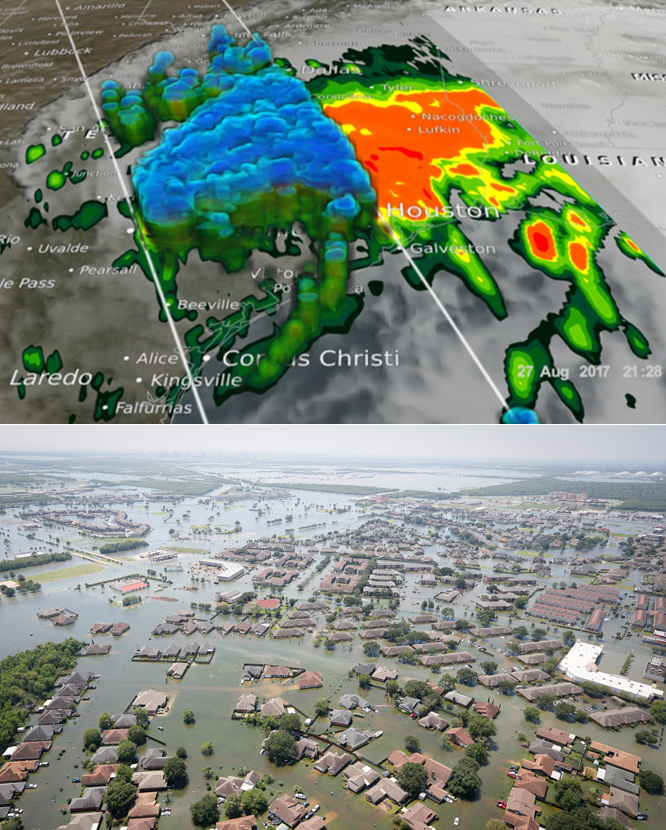
Bottom: Flooding in Texas on August 31, 2017. Credit: SC National Guard (170831-Z-AH923-081, public domain), via Wikimedia Commons
Harvey, like all major storms, did not discriminate. Its floods impacted poor and wealthy alike. Some neighborhoods were wiped out, while others were left untouched.
And it left many wondering: could it happen again?
Harvey was a so-called “500-year event.” This means that meteorologists project 1 in 500 odds that a flood of that size will happen in a given year.
The incredible thing is that Harvey was the third 500-year flood in Houston in just 3 years. The odds of that happening are very long indeed.
This suggests that the probability system may need to be revised, and that in the future, severe floods may be more likely.
There is no “normal” in nature. It’s always changing. Nature doesn’t adapt to humans; humans must adapt to nature.
Houston is located on a marshy plain. Its soils don’t drain well ... but they hardly drain at all when covered in concrete or asphalt. Houston has grown successfully, but future plans should maximize green space and minimize impermeable cover.
Since its land is flat, the rivers and bayous that drain Houston are slow moving, and prone to overflow. The city must accelerate efforts to widen and improve them, and consider barriers to block storm surge from pushing water back up them.
As population grows, there will be a temptation to expand into flood-prone areas. The city has been warning developers against this but should step up efforts.
The good news is, with careful planning and management, Houston should be able to minimize the impact of future storms.
Background
Synopsis: Hurricane Harvey was the wettest tropical cyclone on record in the United States, with peak accumulations of up to 65 inches of rain. It was an extremely destructive hurricane, made more devastating because of dense urban development.
- Landfall of a hurricane with this level of intensity had not occurred in 12 years in the United States.
- On August 24, 2017, Hurricane Harvey intensified rapidly over the Gulf of Mexico to become a Category 4 hurricane with peak winds of up to 130 mph as it made landfall near Rockport, Texas, late on August 25.
- It bounced back into Copano Bay and made another landfall near Holiday Beach.
- The storm then weakened and stalled and rambled slowly eastward, dropping unprecedented amounts of rain, especially on its northeastern “wet” side, until August 28.
- Hurricane Harvey emerged back into the Gulf of Mexico on August 28 before making final landfall in Cameron, Louisiana, on August 29.
- From August 25 to 28, many areas in southeastern Texas received more than 40 inches of rain; some received up to 65 inches.
- Urban-development drainage systems in the Houston-area sprawl were overwhelmed.
- Hundreds of thousands of homes in densely populated coastal Texas were inundated during the unprecedented rainfall and days of flooding that followed, leading to estimates of $70–200 billion in losses, much sustained by uninsured homeowners.
- Hurricane Harvey caused at least 76 deaths in the United States.

